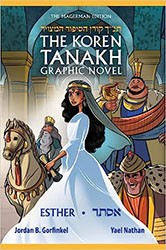If you are ready to approach the Passover seder in a thoroughly different way — one with irony and humor, yet supported by deep reverence for tradition — then it’s time to open Jordan B. Gorfinkel and Erez Zadok’s Passover Haggadah Graphic Novel. Koren’s new publication contains the complete ritual, and it is strictly kosher, as the book’s guide, a goat arrayed in human clothing, assures its readers. In the same panel, the goat, wearing a Superman costume, explains that this haggadah — with its full Hebrew and Aramaic text, as well as transliteration and English translation — will offer instructions and also tell the story of the Exodus in the style of comic books, “a Jewish innovation, you know.” (Gorfinkel is a former Batman artist, following in the tradition of the Caped Crusader’s Jewish creators, Bob Kane and Bill Finger.) From blessing the first cup of wine at kadesh,to the concluding nirtzah, with hopeful expressions of celebration in Jerusalem, this seder is an action-packed and innovative adventure full of unforgettable characters and excursions through Jewish history.
Since any complete haggadah is, by definition, a collection of prayers, rituals, stories, and songs, Gorfinkel has not departed from norms, but rather seized the maximum creative potential inherent in this unique book. If you are skeptical when the goat guide compares post-Temple era seders to “dinner theater,” the pace of his narrative and its genuinely inclusive spirit will win you over. His goat family sets up the seder plate with joyful enthusiasm; the father hauls a huge shank bone, while the little girl bounces on the hard-boiled egg as if it were a Pilates ball. Mom sways the parsley over her head like an interpretive dancer. Accompanying this accessible image are speech balloons with clear explanations of all the required items. Then, as the narration itself begins in the maggid section, Zadok’s illustrations show the cosmos with planets aligned with a picture of round matzah and a wine goblet. Finally, an image of a glove and a shining sun takes us to Egypt, where the seder metaphor becomes reality.
There are many different kinds of Jews in this haggadah — Jews of different races, generations, and genders. Just as the scenes of slave labor in Egypt make human suffering real, so do the modern comic strip sections of urban residents portray compassion. An aged patient leaving a hospital reminds readers that they must “Let anyone who is hungry,” “come and eat.” (The second half of the sentence is said by a physician walking out of an emergency room.) Other pictures also shake readers out of any sense of complacency about the familiar ritual. The idolatry of our ancestors is transformed into an image of a menacing statue in the Soviet Union, while the crossing of the Red Sea includes women and men of every color and era, with cameo appearances by Natan Sharansky, David Ben-Gurion, and Steven Spielberg. The descriptions of the four types of sons who learn the meaning of the seder includes daughters as well. Zadok’s depiction of the plagues includes an enraged and grief-stricken Pharaoh cradling the lifeless body of his son, an effective message about the tragic dimension of achieving freedom.
This haggadah’s embrace of inclusivity is not a calculated gesture towards relevance; virtually every page reflects the diversity of the Jewish people. In singing “Avadim Hayinu,” Jews are instructed to viscerally remember that our ancestors were slaves. The understated text and casual pictures remind readers that all of us, “people with great wisdom, all people with great perception, all respected elders, all well-versed in the Torah,” benefit by this reminder. The portraits of these wise individuals include a businessman holding an electronic tablet, a woman of color hiking with a backpack, a hipster playing electric guitar, and a grandmother instructing her granddaughter in Torah while the girl stands on a basketball. The song “Echad Mi Yodea,” (“Who Knows One?”) shows the four matriarchs carved on Mount Rushmore. These interpretations appear along with classic images of the historic narrative. One of the most moving sequences expresses the continuity of God’s promise to the people of Israel. It begins with labor under Pharaoh, and progresses to liberation, and then shows further torments under the Nazis. Adolf Eichmann replaces Pharaoh, but is brought to justice in an Israeli courtroom. Finally, a modern family celebrates a baby’s bris, the ongoing symbol of this relationship.
Passover Haggadah Graphic Novelis highly recommended for both children and adults. Any child old enough to look at pictures will benefit from it, and adults who have used any other haggadah will find new meaning in this one.
Emily Schneider writes about literature, feminism, and culture for Tablet, The Forward, The Horn Book, and other publications, and writes about children’s books on her blog. She has a Ph.D. in Romance Languages and Literatures.




